Chenyu Yang
Soft Robotics Lab, IRIS, D-MAVT, ETH Zurich, Switzerland
Beyond Anthropomorphism: Enhancing Grasping and Eliminating a Degree of Freedom by Fusing the Abduction of Digits Four and Five
Sep 16, 2025Abstract:This paper presents the SABD hand, a 16-degree-of-freedom (DoF) robotic hand that departs from purely anthropomorphic designs to achieve an expanded grasp envelope, enable manipulation poses beyond human capability, and reduce the required number of actuators. This is achieved by combining the adduction/abduction (Add/Abd) joint of digits four and five into a single joint with a large range of motion. The combined joint increases the workspace of the digits by 400\% and reduces the required DoFs while retaining dexterity. Experimental results demonstrate that the combined Add/Abd joint enables the hand to grasp objects with a side distance of up to 200 mm. Reinforcement learning-based investigations show that the design enables grasping policies that are effective not only for handling larger objects but also for achieving enhanced grasp stability. In teleoperated trials, the hand successfully performed 86\% of attempted grasps on suitable YCB objects, including challenging non-anthropomorphic configurations. These findings validate the design's ability to enhance grasp stability, flexibility, and dexterous manipulation without added complexity, making it well-suited for a wide range of applications.
Towards Hallucination-Free Music: A Reinforcement Learning Preference Optimization Framework for Reliable Song Generation
Aug 07, 2025Abstract:Recent advances in audio-based generative language models have accelerated AI-driven lyric-to-song generation. However, these models frequently suffer from content hallucination, producing outputs misaligned with the input lyrics and undermining musical coherence. Current supervised fine-tuning (SFT) approaches, limited by passive label-fitting, exhibit constrained self-improvement and poor hallucination mitigation. To address this core challenge, we propose a novel reinforcement learning (RL) framework leveraging preference optimization for hallucination control. Our key contributions include: (1) Developing a robust hallucination preference dataset constructed via phoneme error rate (PER) computation and rule-based filtering to capture alignment with human expectations; (2) Implementing and evaluating three distinct preference optimization strategies within the RL framework: Direct Preference Optimization (DPO), Proximal Policy Optimization (PPO), and Group Relative Policy Optimization (GRPO). DPO operates off-policy to enhance positive token likelihood, achieving a significant 7.4% PER reduction. PPO and GRPO employ an on-policy approach, training a PER-based reward model to iteratively optimize sequences via reward maximization and KL-regularization, yielding PER reductions of 4.9% and 4.7%, respectively. Comprehensive objective and subjective evaluations confirm that our methods effectively suppress hallucinations while preserving musical quality. Crucially, this work presents a systematic, RL-based solution to hallucination control in lyric-to-song generation. The framework's transferability also unlocks potential for music style adherence and musicality enhancement, opening new avenues for future generative song research.
LeVo: High-Quality Song Generation with Multi-Preference Alignment
Jun 09, 2025Abstract:Recent advances in large language models (LLMs) and audio language models have significantly improved music generation, particularly in lyrics-to-song generation. However, existing approaches still struggle with the complex composition of songs and the scarcity of high-quality data, leading to limitations in sound quality, musicality, instruction following, and vocal-instrument harmony. To address these challenges, we introduce LeVo, an LM-based framework consisting of LeLM and a music codec. LeLM is capable of parallelly modeling two types of tokens: mixed tokens, which represent the combined audio of vocals and accompaniment to achieve vocal-instrument harmony, and dual-track tokens, which separately encode vocals and accompaniment for high-quality song generation. It employs two decoder-only transformers and a modular extension training strategy to prevent interference between different token types. To further enhance musicality and instruction following, we introduce a multi-preference alignment method based on Direct Preference Optimization (DPO). This method handles diverse human preferences through a semi-automatic data construction process and DPO post-training. Experimental results demonstrate that LeVo consistently outperforms existing methods on both objective and subjective metrics. Ablation studies further justify the effectiveness of our designs. Audio examples are available at https://levo-demo.github.io/.
SongBloom: Coherent Song Generation via Interleaved Autoregressive Sketching and Diffusion Refinement
Jun 09, 2025Abstract:Generating music with coherent structure, harmonious instrumental and vocal elements remains a significant challenge in song generation. Existing language models and diffusion-based methods often struggle to balance global coherence with local fidelity, resulting in outputs that lack musicality or suffer from incoherent progression and mismatched lyrics. This paper introduces $\textbf{SongBloom}$, a novel framework for full-length song generation that leverages an interleaved paradigm of autoregressive sketching and diffusion-based refinement. SongBloom employs an autoregressive diffusion model that combines the high fidelity of diffusion models with the scalability of language models. Specifically, it gradually extends a musical sketch from short to long and refines the details from coarse to fine-grained. The interleaved generation paradigm effectively integrates prior semantic and acoustic context to guide the generation process. Experimental results demonstrate that SongBloom outperforms existing methods across both subjective and objective metrics and achieves performance comparable to the state-of-the-art commercial music generation platforms. Audio samples are available on our demo page: https://cypress-yang.github.io/SongBloom\_demo.
ZeroGUI: Automating Online GUI Learning at Zero Human Cost
May 29, 2025Abstract:The rapid advancement of large Vision-Language Models (VLMs) has propelled the development of pure-vision-based GUI Agents, capable of perceiving and operating Graphical User Interfaces (GUI) to autonomously fulfill user instructions. However, existing approaches usually adopt an offline learning framework, which faces two core limitations: (1) heavy reliance on high-quality manual annotations for element grounding and action supervision, and (2) limited adaptability to dynamic and interactive environments. To address these limitations, we propose ZeroGUI, a scalable, online learning framework for automating GUI Agent training at Zero human cost. Specifically, ZeroGUI integrates (i) VLM-based automatic task generation to produce diverse training goals from the current environment state, (ii) VLM-based automatic reward estimation to assess task success without hand-crafted evaluation functions, and (iii) two-stage online reinforcement learning to continuously interact with and learn from GUI environments. Experiments on two advanced GUI Agents (UI-TARS and Aguvis) demonstrate that ZeroGUI significantly boosts performance across OSWorld and AndroidLab environments. The code is available at https://github.com/OpenGVLab/ZeroGUI.
MAPLE: Encoding Dexterous Robotic Manipulation Priors Learned From Egocentric Videos
Apr 08, 2025Abstract:Large-scale egocentric video datasets capture diverse human activities across a wide range of scenarios, offering rich and detailed insights into how humans interact with objects, especially those that require fine-grained dexterous control. Such complex, dexterous skills with precise controls are crucial for many robotic manipulation tasks, yet are often insufficiently addressed by traditional data-driven approaches to robotic manipulation. To address this gap, we leverage manipulation priors learned from large-scale egocentric video datasets to improve policy learning for dexterous robotic manipulation tasks. We present MAPLE, a novel method for dexterous robotic manipulation that exploits rich manipulation priors to enable efficient policy learning and better performance on diverse, complex manipulation tasks. Specifically, we predict hand-object contact points and detailed hand poses at the moment of hand-object contact and use the learned features to train policies for downstream manipulation tasks. Experimental results demonstrate the effectiveness of MAPLE across existing simulation benchmarks, as well as a newly designed set of challenging simulation tasks, which require fine-grained object control and complex dexterous skills. The benefits of MAPLE are further highlighted in real-world experiments using a dexterous robotic hand, whereas simultaneous evaluation across both simulation and real-world experiments has remained underexplored in prior work.
ORCA: An Open-Source, Reliable, Cost-Effective, Anthropomorphic Robotic Hand for Uninterrupted Dexterous Task Learning
Apr 05, 2025Abstract:General-purpose robots should possess humanlike dexterity and agility to perform tasks with the same versatility as us. A human-like form factor further enables the use of vast datasets of human-hand interactions. However, the primary bottleneck in dexterous manipulation lies not only in software but arguably even more in hardware. Robotic hands that approach human capabilities are often prohibitively expensive, bulky, or require enterprise-level maintenance, limiting their accessibility for broader research and practical applications. What if the research community could get started with reliable dexterous hands within a day? We present the open-source ORCA hand, a reliable and anthropomorphic 17-DoF tendon-driven robotic hand with integrated tactile sensors, fully assembled in less than eight hours and built for a material cost below 2,000 CHF. We showcase ORCA's key design features such as popping joints, auto-calibration, and tensioning systems that significantly reduce complexity while increasing reliability, accuracy, and robustness. We benchmark the ORCA hand across a variety of tasks, ranging from teleoperation and imitation learning to zero-shot sim-to-real reinforcement learning. Furthermore, we demonstrate its durability, withstanding more than 10,000 continuous operation cycles - equivalent to approximately 20 hours - without hardware failure, the only constraint being the duration of the experiment itself. All design files, source code, and documentation will be available at https://www.orcahand.com/.
SongEditor: Adapting Zero-Shot Song Generation Language Model as a Multi-Task Editor
Dec 18, 2024



Abstract:The emergence of novel generative modeling paradigms, particularly audio language models, has significantly advanced the field of song generation. Although state-of-the-art models are capable of synthesizing both vocals and accompaniment tracks up to several minutes long concurrently, research about partial adjustments or editing of existing songs is still underexplored, which allows for more flexible and effective production. In this paper, we present SongEditor, the first song editing paradigm that introduces the editing capabilities into language-modeling song generation approaches, facilitating both segment-wise and track-wise modifications. SongEditor offers the flexibility to adjust lyrics, vocals, and accompaniments, as well as synthesizing songs from scratch. The core components of SongEditor include a music tokenizer, an autoregressive language model, and a diffusion generator, enabling generating an entire section, masked lyrics, or even separated vocals and background music. Extensive experiments demonstrate that the proposed SongEditor achieves exceptional performance in end-to-end song editing, as evidenced by both objective and subjective metrics. Audio samples are available in \url{https://cypress-yang.github.io/SongEditor_demo/}.
PVC: Progressive Visual Token Compression for Unified Image and Video Processing in Large Vision-Language Models
Dec 12, 2024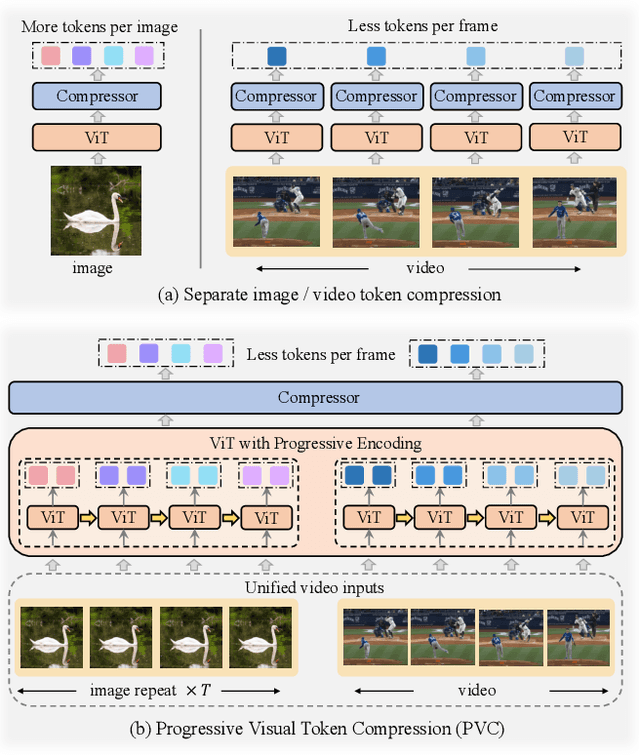
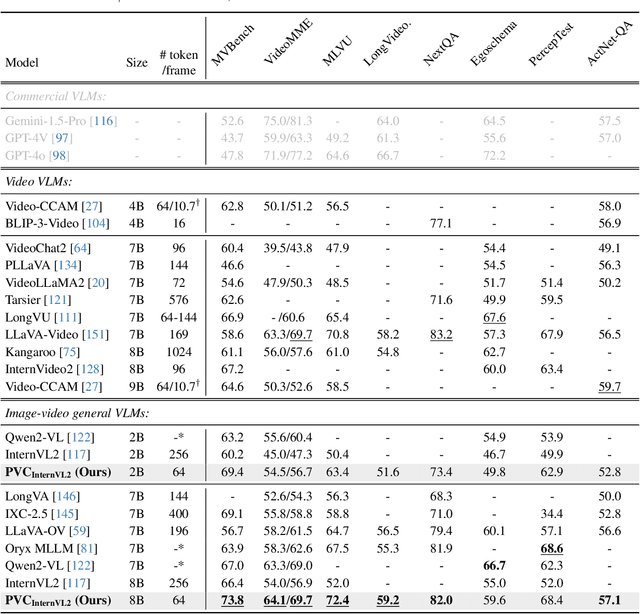
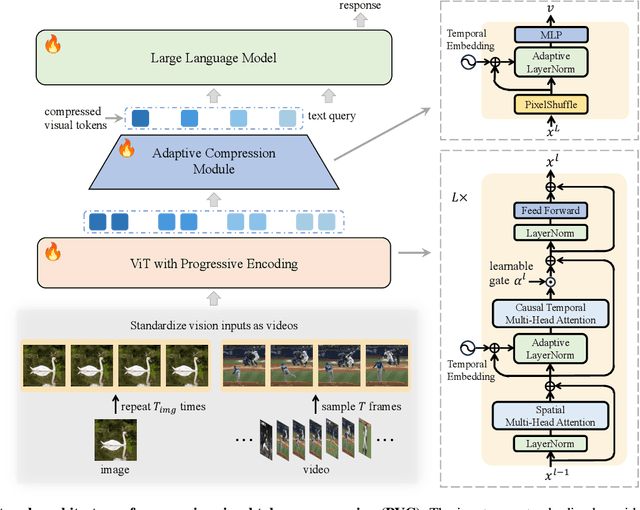
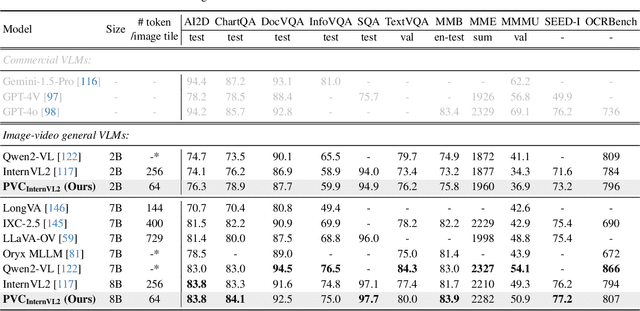
Abstract:Large Vision-Language Models (VLMs) have been extended to understand both images and videos. Visual token compression is leveraged to reduce the considerable token length of visual inputs. To meet the needs of different tasks, existing high-performance models usually process images and videos separately with different token compression strategies, limiting the capabilities of combining images and videos. To this end, we extend each image into a "static" video and introduce a unified token compression strategy called Progressive Visual Token Compression (PVC), where the tokens of each frame are progressively encoded and adaptively compressed to supplement the information not extracted from previous frames. Video tokens are efficiently compressed with exploiting the inherent temporal redundancy. Images are repeated as static videos, and the spatial details can be gradually supplemented in multiple frames. PVC unifies the token compressing of images and videos. With a limited number of tokens per frame (64 tokens by default), spatial details and temporal changes can still be preserved. Experiments show that our model achieves state-of-the-art performance across various video understanding benchmarks, including long video tasks and fine-grained short video tasks. Meanwhile, our unified token compression strategy incurs no performance loss on image benchmarks, particularly in detail-sensitive tasks.
VQ-ACE: Efficient Policy Search for Dexterous Robotic Manipulation via Action Chunking Embedding
Nov 05, 2024


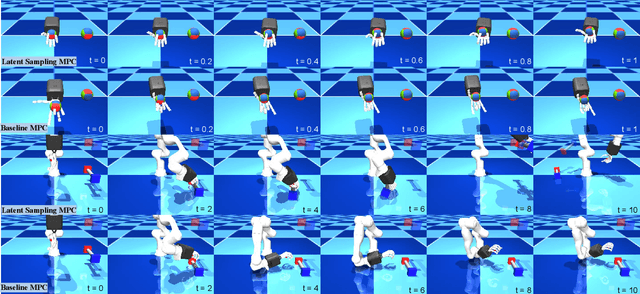
Abstract:Dexterous robotic manipulation remains a significant challenge due to the high dimensionality and complexity of hand movements required for tasks like in-hand manipulation and object grasping. This paper addresses this issue by introducing Vector Quantized Action Chunking Embedding (VQ-ACE), a novel framework that compresses human hand motion into a quantized latent space, significantly reducing the action space's dimensionality while preserving key motion characteristics. By integrating VQ-ACE with both Model Predictive Control (MPC) and Reinforcement Learning (RL), we enable more efficient exploration and policy learning in dexterous manipulation tasks using a biomimetic robotic hand. Our results show that latent space sampling with MPC produces more human-like behavior in tasks such as Ball Rolling and Object Picking, leading to higher task success rates and reduced control costs. For RL, action chunking accelerates learning and improves exploration, demonstrated through faster convergence in tasks like cube stacking and in-hand cube reorientation. These findings suggest that VQ-ACE offers a scalable and effective solution for robotic manipulation tasks involving complex, high-dimensional state spaces, contributing to more natural and adaptable robotic systems.
 Add to Chrome
Add to Chrome Add to Firefox
Add to Firefox Add to Edge
Add to Edge